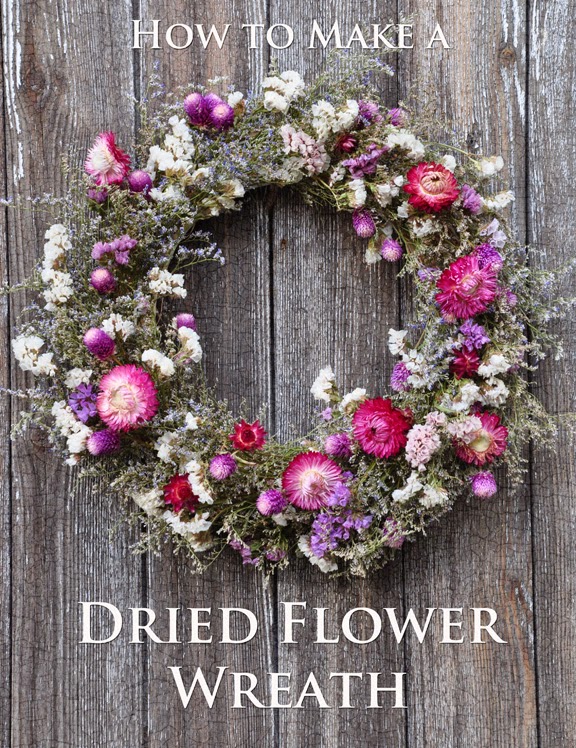Now is the time to think about preserving some of summer's bounty and carrying it into the fall with a dried flower arrangement or wreath.
Things you'll need:
• Dried flowers and a large bunch of dried Sea Lavender or Limonium latifolia
• Wire wreath frame (I got mine and Michael's. I was afraid that the dark green of the wire frame might show through, so I quickly spray painted it white.)
• Raffia, Spanish moss or some other material of your choice to fill the wire frame.
• Light gage florist's wire
• Scissors
Find simple techniques for drying flowers in this blog post.
Begin by stuffing the inside of your wire wreath form. The goal here is to fill the wire frame with some sort of material that will catch and trap the dried flower stems that you will insert into it.
You can use an array of materials including Spanish Moss (grey in color) or fine wood shavings (often used to line Easter baskets). I used Raffia for my wreath. Unlike the Spanish Moss, there are no issues with allergies, and it comes in a convenient coil that I simply unwound and placed into the reverse side of my wreath form.
Twist florist's wire into a knot on the outside edge of your wire frame. Wrap it around and around the frame to hold the raffia in place. Once you have gone the whole way around the circular form, twist the end of your florist's wire onto the inside of the frame to secure it.
Next you need to create a pretty backdrop for your dried flowers.
I would have preferred to use German Statice, which is very sturdy and easy to work with. In this instance, I was only able to find Sea Lavender or Limonium latifolia, which is much finer and more delicate. Its feathery branches can snap unexpectedly, if you are not careful.
(A note about availability: Statice of varying kinds is commonly available most places you buy cut flowers. I have even seen it at my local grocery store in the floral department at this time of year. A local farmer's market is also a good place to look for it.)
You may find your dried Sea Lavender branches will shed some of the tiny blue flowers, so choose a smooth surface on which to work that will make sweeping up any flowers that drop fast and easy.
Break off short stems from your bundle of dried Sea Lavender that are approximately five or six inches in length.
Gather a few of the short lengths into a bunch and insert the them into the wreath allowing them to catch in the tangle of raffia.
Continue inserting small bunches of Sea Lavender, working your way around the wreath.
(Tip: I found that it was best to work in a single direction, placing one bunch in the centre, then one on the inside edge and finally one of the outside edge of the wreath.)
Here is the completed backdrop of Sea Lavender.
Next, gather together your dried flowers. Shorten the stem length to about a five or six inches by snapping the flowers off.
Work with the largest type of dried flower first. In my case it was the Statice, Limonium Sinuatum.
Insert the flowers into the wreath, again moving in a single direction around the circular wreath. Like the Sea Lavender, the flowers should catch in the raffia.
I placed all the white colored Statice (Limonium Sinuatum) first
and then moved on to purple flowers.
Next, I added in this pretty magenta Gomphrena.
The wreath with Statice, Limonium Sinuatum and the Gomphrena in place.
Now for the final touch, I added in the Strawflowers.
Here is the finished project.
When I was finished, I still had a small bunch of dried Gomphrena flowers left over. So I decided to make another wreath.
I snapped the flowers off leaving a half inch of stem on each. Then I hot glued the flowers onto a small grapevine wreath.
Here is the completed wreath.





















